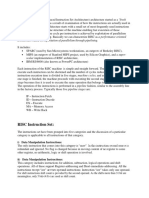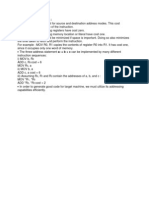Unit - Viii Machine Dependent Code Optimization Peephole Optimization
Unit - Viii Machine Dependent Code Optimization Peephole Optimization
Uploaded by
Mamatha LaxmiCopyright:
Available Formats
Unit - Viii Machine Dependent Code Optimization Peephole Optimization
Unit - Viii Machine Dependent Code Optimization Peephole Optimization
Uploaded by
Mamatha LaxmiOriginal Description:
Original Title
Copyright
Available Formats
Share this document
Did you find this document useful?
Is this content inappropriate?
Copyright:
Available Formats
Unit - Viii Machine Dependent Code Optimization Peephole Optimization
Unit - Viii Machine Dependent Code Optimization Peephole Optimization
Uploaded by
Mamatha LaxmiCopyright:
Available Formats
VIEW A.N.
Suresh
1
UNIT VIII
MACHINE DEPENDENT CODE OPTIMIZATION
PEEPHOLE OPTIMIZATION
Generate code and then improve the quality of the target code by applying "optimizing"
transformations to the target program. Many simple transformations can significantly improve
the running time or space requirement of the target program.
A simple technique for locally improving the target code is peephole optimization, which
is done by examining a sliding window of target instructions (called the peephole).
Replacing instruction sequences within the peephole by a shorter or faster sequence,
whenever possible.
Peephole optimization can also be applied directly after intermediate code generation to
improve the intermediate representation.
The peephole is a small, sliding window on a program. The code in the peephole need not
be contiguous, although some implementations do require this.. In general, repeated passes over
the target code are necessary to get the maximum benefit.
The following examples of program transformations that are characteristic of peephole
optimizations:
Redundant-instruction elimination
Flow-of-control optimizations
Algebraic simplifications
Use of machine idioms
1) Eliminating Redundant Loads and Stores:
If we see the instruction sequence
LD a, RO
ST RO, a
in a target program, we can delete the store instruction because whenever it is executed, the first
instruction will ensure that the value of a has already been loaded into register RO.
Note that if the store instruction had a label, we could not be sure that the first instruction
is always executed before the second, so we could not remove the store instruction
.
The two instructions have to be in the same basic block for this transformation to be safe.
VIEW A.N.Suresh
2
2) Eliminating Unreachable Code
Another opportunity for peephole optimization is the removal of unreachable
instructions. An unlabeled instruction immediately following an unconditional jump may be
removed. This operation can be repeated to eliminate a sequence of instructions.
For example, for debugging purposes, a large program may have within it certain code
fragments that are executed only if a variable debug is equal to 1.
In the intermediate representation, this code may look like
if debug == 1 goto LI
goto L2
LI: print debugging information
L2:
One obvious peephole optimization is to eliminate jumps over jumps,
if debug != 1 goto L2
print debugging information
L2:
If debug is set to 0 at the beginning of the program, constant propagation would transform this
sequence into
if 0 != 1 goto L2
print debugging information
L2:
Now the argument of the first statement always evaluates to true, so the statement can be
replaced by goto L2. Then all statements that print debugging information are unreachable and
can be eliminated one at a time.
3 ) Flow-of-Control Optimizations
Simple intermediate code-generation algorithms frequently produce jumps to jumps,
jumps to conditional jumps, or conditional jumps to jumps. These unnecessary jumps can be
eliminated in either the intermediate code or the target code by the following types of peephole
optimizations.
We can replace the sequence
goto Li
LI: goto L2
by the sequence
goto L2
LI: goto L2
If there are now no jumps to LI, then it may be possible to eliminate the statement
LI: goto L2 provided it is preceded by an unconditional jump.
Similarly, the sequence
if a < b goto LI
VIEW A.N.Suresh
3
LI: goto L2
Can be replaced by the sequence
if a < b goto L2
LI: goto L2
Suppose there is only one jump to LI and LI is preceded by an unconditional goto. Then
the sequence
goto LI
LI: if a < b goto L2
L3:
may be replaced by the sequence
if a < b goto L2
goto L3
L3:
While the number of instructions in the two sequences is the same, we sometimes skip
the unconditional jump in the second sequence, but never in the first. Thus, the second
sequence is superior to the first in execution time.
4 )Algebraic Simplification and Reduction in Strength
Algebraic identities that could be used to simplify DAG's. These algebraic identities can
also be used by a peephole optimizer to eliminate three-address statements such as
x = x + 0
or
x = x * 1 in the peephole.
Reduction-in-strength transformations can be applied in the peephole to replace
expensive operations by equivalent cheaper ones on the target machine.
Certain machine instructions are considerably cheaper than others.
Example:
x2 is invariably cheaper to implement as x * x than as a call to an exponentiation routine.
Fixed-point multiplication or division by a power of two is cheaper to implement as a
shift.
Floating-point division by a constant can be approximated as multiplication by a
constant, which may be cheaper.
5) Use of Machine Idioms
The target machine may have hardware instructions to implement certain specific
operations efficiently. For example,
Some machines have auto-increment and auto-decrement addressing modes.
These add or subtract one from an operand before or after using its value. The use of the
modes greatly improves the quality of code when pushing or popping a stack, as in
parameter passing.
VIEW A.N.Suresh
4
REGISTER ALLOCATION
Instructions involving only register operands are faster than those involving memory
operands. Therefore, efficient utilization of registers is vitally important in generating good
code.
One approach to register allocation and assignment is to assign specific values in the
target program to certain registers. For example, we could decide to assign base addresses to one
group of registers, arithmetic computations to another, the top of the stack to a fixed register, and
so on.
Advantage: It simplifies the design of a code generator.
Disadvantage : It uses registers inefficiently; certain registers may go unused over
substantial portions of code, while unnecessary loads and stores are generated into the
other registers.
Global Register Allocation
All live variables were stored at the end of each block. To save some of these stores and
corresponding loads, we might arrange to assign registers to frequently used variables and keep
these registers consistent across block boundaries (globally).
Since programs spend most of their time in inner loops, a natural approach to global
register assignment is to try to keep a frequently used value in a fixed register throughout a loop.
One strategy for global register allocation is to assign some fixed number of registers to
hold the most active values in each inner loop. The selected values may be different in different
loops. Registers not already allocated may be used to hold values local to one block .
Drawback : The fixed number of registers is not always the right number to make
available for global register allocation.
Usage Counts
The savings to be realized by keeping a variable x in a register for the duration of a loop L
is one unit of cost for each reference to x if x is already in a register.
To generate code for a block, there is a good chance that after x has been computed in a
block it will remain in a register if there are subsequent uses of x in that block.
Thus we count a savings of one for each use of x in loop L that is not preceded by an
assignment to x in the same block. We also save two units if we can avoid a store of x at the end
of a block.
Thus, if x is allocated a register, we count a savings of two for each block in loop L for
which x is live on exit and in which x is assigned a value.
VIEW A.N.Suresh
5
If x is live on entry to the loop header, we must load x into its register just before entering
loop L. This load costs two units. Similarly, for each exit block B of loop L at which x is live on
entry to some successor of B outside of L, we must store x at a cost of two.
Thus, an approximate formula for the benefit to be realized from allocating a register x within
loop L is
where use(x, B) is the number of times x is used in B prior to any definition of x; live(x, B) is 1 if
x is live on exit from B and is assigned a value in B, and live(x, B) is 0 otherwise.
E x a m p l e:
Consider the the basic blocks in the inner loop depicted in Fig. A. Assume
registers RO, Rl, and R2 are allocated to hold values throughout the loop. Variables live on
entry into and on exit from each block.
Fig A
To evaluate x = a, we observe that a is live on exit from B1 and is assigned a value there, but is
not live on exit from B2, B3, or B4. Thus, J2B in L use(a.:B) 2. Hence the value of x a is 4.
That is, four units of cost can be saved by selecting a for one of the global registers. The
values for b, c, d, e, and f are 5, 3, 6, 4, and 4, respectively.
Register Assignment for Outer Loops
If an outer loop L1 contains an inner loop L2, the names allocated registers in L2 need not
be allocated registers in L1 L2. Similarly, if we choose to allocate x a register in L2 but not L1,
we must load x on entrance to L2 and store x on exit from L2.
VIEW A.N.Suresh
6
Register Allocation by Graph Coloring
When a register is needed for a computation but all available registers are in use, the
contents of one of the used registers must be stored (spilled) into a memory location in order to
free up a register. Graph coloring is a simple technique for allocating registers and managing
register spills.
In the method, two passes are used.
1) Target-machine instructions are selected as though there are an infinite number of
symbolic registers; in effect, names used in the intermediate code become names of
registers and the three-address instructions become machine-language instructions.
2) Assign physical registers to symbolic ones. The goal is to find an assignment that
minimizes the cost of spills.
In the second pass, for each procedure a register-interference graph is constructed in
which the nodes are symbolic registers and an edge connects two nodes if one is live at a point
where the other is defined.
A graph is said to be colored if each node has been assigned a color in such a way that no
two adjacent nodes have the same color. A color represents a register, and the color makes sure
that no two symbolic registers that can interfere with each other are assigned the same physical
register.
Garbage collection via reference count
Data that cannot be referenced is generally known as garbage. Many high-level
programming languages remove the burden of manual memory management from the
programmer by offering automatic garbage collection, which de allocates unreachable data.
Design Goals for Garbage Collectors
Garbage collection is the reclamation of chunks of storage holding objects that can no
longer be accessed by a program. Objects have a type that can be determined by the garbage
collector at run time. From the type information, we can tell how large the object is and which
components of the object contain references to other objects.
A Basic Requirement: Type Safety
A language in which the type of any data component can be determined is said to be type
safe. There are type-safe languages like ML, for which we can determine types at compile time.
There are other typesafe languages, like Java, whose types cannot be determined at compile time,
but can be determined at run time.
The latter are called dynamically typed languages. If a language is neither statically nor
dynamically type safe, then it is said to be unsafe.
VIEW A.N.Suresh
7
Unsafe languages, which unfortunately include some of the most important languages
such as C and C + + , are bad candidates for automatic garbage collection.
Performance Metrics
The performance metrics that must be considered when designing a garbage collector are,
Overall Execution Time
Garbage collection can be very slow. It is important that it not significantly increase the
total run time of an application. Since the garbage collector necessarily must touch a lot of data,
its performance is determined greatly by how it leverages the memory subsystem.
Space Usage.
It is important that garbage collection avoid fragmentation and make the best use of the
available memory.
Pause Time.
Simple garbage collectors are notorious for causing programs the mutators to
pause suddenly for an extremely long time, as garbage collection kicks in without warning. Thus,
besides minimizing the overall execution time, it is desirable that the maximum pause time be
minimized. As an important special case, real-time applications require certain computations to
be completed within a time limit. We must either suppress garbage collection while performing
real-time tasks, or restrict maximum pause time. Thus, garbage collection is seldom used in real-
time applications.
Program Locality.
We cannot evaluate the speed of a garbage collector solely by its running time. The
garbage collector controls the placement of data and thus influences the data locality of the
mutator program. It can improve a mutator's temporal locality by freeing up space and reusing it;
it can improve the mutator's spatial locality by relocating data used together in the same cache or
pages.
Reachability
We refer to all the data that can be accessed directly by a program, without having to
dereference any pointer, as the root set For example, in Java the root set of a program consists of
all the static field members and all the variables on its stack. A program obviously can reach any
member of its root set at any time.
Reachability becomes a bit more complex when the program has been optimized by the
compiler.
First, a compiler may keep reference variables in registers. These references must also
be considered part of the root set.
Second, even though in a type-safe language programmers do not get to manipulate
memory addresses directly, a compiler often does so for the sake of speeding up the
code.
VIEW A.N.Suresh
8
Here are some things an optimizing compiler can do to enable the garbage collector
to find the correct root set:
The compiler can restrict the invocation of garbage collection to only certain code points
in the program, when no "hidden" references exist.
The compiler can write out information that the garbage collector can use to recover all
the references, such as specifying which registers contain references, or how to compute
the base address of an object that is given an internal address.
The compiler can assure that there is a reference to the base address of all reachable
objects whenever the garbage collector may be invoked
There are four basic operations that a mutator performs to change the set of
reachable objects
Object Allocations. These are performed by the memory manager, which returns a
reference to each newly allocated chunk of memory. This operation adds members to the
set of reachable objects.
Parameter Passing and Return Values. References to objects are passed from the actual
input parameter to the corresponding formal parameter, and from the returned result back
to the callee. Objects pointed to by these references remain reachable.
Reference Assignments. Assignments of the form u = v, where u and v are references,
have two effects. First, u is now a reference to the object referred to by v. As long as u is
reachable, the object it refers to is surely reachable. Second, the original reference in u is
lost. If this reference is the last to some reachable object, then that object becomes
unreachable. Any time an object becomes unreachable, all objects that are reachable only
through references contained in that object also become unreachable.
Procedure Returns. As a procedure exits, the frame holding its local variables is popped
off the stack. If the frame holds the only reachable reference to any object, that object
becomes unreachable. Again, if the now unreachable objects hold the only references to
other objects, they too become unreachable, and so on.
Reference Counting Garbage Collectors
Consider a simple, garbage collector, based on reference counting, which identifies garbage
as an object changes from being reachable to unreachable; the object can be deleted when its
count drops to zero. With a reference-counting garbage collector, every object must have a field
for the reference count.
Reference counts can be maintained as follows:
1. Object Allocation. The reference count of the new object is set to 1.
VIEW A.N.Suresh
9
2. Parameter Passing. The reference count of each object passed into a
procedure is incremented.
3. Reference Assignments. For statement u = v, where u and v are references,
the reference count of the object referred to by v goes up by one,
and the count for the old object referred to by u goes down by one.
4. Procedure Returns. As a procedure exits, all the references held by the
local variables of that procedure activation record must also be decremented.
If several local variables hold references to the same object, that
object's count must be decremented once for each such reference.
5. Transitive Loss of Reachability. Whenever the reference count of an object
becomes zero, we must also decrement the count of each object pointed
to by a reference within the object.
You might also like
- 3 CO and CGDocument11 pages3 CO and CGmasarath sabaNo ratings yet
- MCA 0705 II UNIT 5 Code Optimization & Code GenerationDocument10 pagesMCA 0705 II UNIT 5 Code Optimization & Code GenerationDr. V. Padmavathi Associate ProfessorNo ratings yet
- Code OptmizeDocument41 pagesCode OptmizeAkshay SNo ratings yet
- Unit 4 CDDocument8 pagesUnit 4 CDankitprajapat403No ratings yet
- Code Optimization and Target Code GenerationDocument24 pagesCode Optimization and Target Code GenerationMd. Abdul MukitNo ratings yet
- Compiler Design Unit-5Document24 pagesCompiler Design Unit-5chandutalari07No ratings yet
- Code Optimiztion Criteria For Code-Improving TransformationsDocument10 pagesCode Optimiztion Criteria For Code-Improving Transformationsapi-20012397No ratings yet
- Rohini 56509347058Document4 pagesRohini 56509347058GORAKAL NARESHNo ratings yet
- Notes On Peephole OptimizationDocument2 pagesNotes On Peephole OptimizationVivek and ClashNo ratings yet
- Code Optimization PDFDocument25 pagesCode Optimization PDFSarvesh HalbeNo ratings yet
- AT&CD Unit 5Document13 pagesAT&CD Unit 5nothingnewtonnew10No ratings yet
- CD - CH6 - Introduction To Code OptimizationDocument19 pagesCD - CH6 - Introduction To Code OptimizationmengistuNo ratings yet
- Compiler DesignDocument20 pagesCompiler Designsunkaralokesh0No ratings yet
- Unit 5Document54 pagesUnit 5ritikshah1206No ratings yet
- CD+-+CH 8Document17 pagesCD+-+CH 8shivanipate05No ratings yet
- Unit 4Document16 pagesUnit 4mullapudijyothivinaykumarNo ratings yet
- How Do You Determine Whether A Loop Ended PrematurelyDocument4 pagesHow Do You Determine Whether A Loop Ended PrematurelyLakshmi PrabhaNo ratings yet
- CodeOptimization EnggNotesDocument7 pagesCodeOptimization EnggNotesMohammad Yaseen PashaNo ratings yet
- Compiler Design - Code OptimizationDocument6 pagesCompiler Design - Code OptimizationSUKRIT SAHUNo ratings yet
- CH5 1Document23 pagesCH5 1sam negroNo ratings yet
- TPL 6 Chapter (Short Answers) : Use Postfix Notation Two Programming LanguagesDocument7 pagesTPL 6 Chapter (Short Answers) : Use Postfix Notation Two Programming Languagessania ejazNo ratings yet
- Compiler Design Code GenerationDocument4 pagesCompiler Design Code GenerationNera AjahhNo ratings yet
- Unit 5 - Compiler Design - WWW - Rgpvnotes.in PDFDocument15 pagesUnit 5 - Compiler Design - WWW - Rgpvnotes.in PDFApNo ratings yet
- Peephole OptimizationDocument12 pagesPeephole Optimizationnexexa6242No ratings yet
- peep hole optimizationDocument3 pagespeep hole optimizationlovelymurali904No ratings yet
- RISC Instruction Set:: I) Data Manipulation InstructionsDocument8 pagesRISC Instruction Set:: I) Data Manipulation InstructionsSwarup BharNo ratings yet
- Peephole Optimization PDFDocument20 pagesPeephole Optimization PDFSwapnil ShindeNo ratings yet
- Lab Session 6Document10 pagesLab Session 6toobafar004No ratings yet
- CD Unit 5Document9 pagesCD Unit 5Ganesh DegalaNo ratings yet
- Vision 2024 CD Chapter 5 Compiler Code Optimization 731689660928542Document24 pagesVision 2024 CD Chapter 5 Compiler Code Optimization 731689660928542Aman KoliNo ratings yet
- Pcs - 2mDocument6 pagesPcs - 2mMikeSteveNo ratings yet
- Unit 4Document19 pagesUnit 4kirlasurya2002No ratings yet
- Com 413 Ammar Usman Sabo H21CS018Document16 pagesCom 413 Ammar Usman Sabo H21CS018ammarusmansabo117No ratings yet
- Oral Question Bank With AnswersDocument14 pagesOral Question Bank With Answersसिद्धांत देशमुखेNo ratings yet
- @@code OptimDocument20 pages@@code Optimobwani777No ratings yet
- Compiler Design Code OptimizationDocument5 pagesCompiler Design Code OptimizationSaiTejaNo ratings yet
- Tips To Optimize Your Verilog HDL CodeDocument9 pagesTips To Optimize Your Verilog HDL CodeZaheer AbbasNo ratings yet
- Tips of Embedded CDocument6 pagesTips of Embedded Cmahamd saiedNo ratings yet
- Rohini 12385088871Document4 pagesRohini 12385088871GORAKAL NARESHNo ratings yet
- Unit - Iv Run Time Storage OrganizationDocument15 pagesUnit - Iv Run Time Storage Organizationashok koppoluNo ratings yet
- (Text) The 80x86 IBM PC and Compatible Computers ReducedDocument1,019 pages(Text) The 80x86 IBM PC and Compatible Computers ReducedmigadNo ratings yet
- Quick Primer On LLVM IR: (For Those Already Familiar With LLVM IR, Feel Free To)Document13 pagesQuick Primer On LLVM IR: (For Those Already Familiar With LLVM IR, Feel Free To)Chinmay AgnihotriNo ratings yet
- From: Chapter 1, The Dragon Book, 2nd EdDocument32 pagesFrom: Chapter 1, The Dragon Book, 2nd EdVivek SharmaNo ratings yet
- What are the roles of ALUDocument150 pagesWhat are the roles of ALUAyush GuptaNo ratings yet
- Unit Iv - Syntax Directed Translation & Run Time EnvironmentDocument8 pagesUnit Iv - Syntax Directed Translation & Run Time Environmentshailesh waranNo ratings yet
- Constant Propagation: CS 701 Fall 2007Document18 pagesConstant Propagation: CS 701 Fall 2007SahilNo ratings yet
- CH5 1Document22 pagesCH5 1kidanewoldhailu1No ratings yet
- Module 3 (Part2)Document68 pagesModule 3 (Part2)vidhya_bineeshNo ratings yet
- Chapter 7 Code Optimization and Code GenerationDocument7 pagesChapter 7 Code Optimization and Code GenerationAdugna NegeroNo ratings yet
- Code Generation and Instruction Selection Unit-8Document6 pagesCode Generation and Instruction Selection Unit-8Sridhar Vangapally VNo ratings yet
- Algorithm and Pseudo CodesDocument44 pagesAlgorithm and Pseudo CodesLady GatlabayanNo ratings yet
- Unit V - Code Optimization and Code Generation: Course MaterialDocument41 pagesUnit V - Code Optimization and Code Generation: Course MaterialTanmay RaoNo ratings yet
- Compiler Design 10Document5 pagesCompiler Design 10ruhinalmuhitNo ratings yet
- Rohini 79541034505Document5 pagesRohini 79541034505GORAKAL NARESHNo ratings yet
- Algorithmandpseudocodes 120630115656 Phpapp02Document44 pagesAlgorithmandpseudocodes 120630115656 Phpapp02ronthefourthNo ratings yet
- Unit 4Document4 pagesUnit 4akum40915No ratings yet
- Mic CT-2Document11 pagesMic CT-2manaskadganchi2006kNo ratings yet
- Artifact FLO1 2 ELab Learning ToolsDocument31 pagesArtifact FLO1 2 ELab Learning ToolsMurali KrishnaNo ratings yet
- Rejoice: Do Not Copy. For This Material Call - 9705551427 Page 1Document9 pagesRejoice: Do Not Copy. For This Material Call - 9705551427 Page 1sampurnakumarNo ratings yet
- ORACLE PL/SQL Interview Questions You'll Most Likely Be AskedFrom EverandORACLE PL/SQL Interview Questions You'll Most Likely Be AskedRating: 5 out of 5 stars5/5 (1)
- MPLS ROUTER Cisco ASR920Document94 pagesMPLS ROUTER Cisco ASR920Artiom GruzinNo ratings yet
- Unit 4 Chapter 1 Storage and QueryingDocument37 pagesUnit 4 Chapter 1 Storage and Queryingvedantbailmare22No ratings yet
- T05 MapReduceDocument20 pagesT05 MapReduceabdulazizbinyabtempNo ratings yet
- Assembly LanguageDocument17 pagesAssembly Languagemisanthropo100% (1)
- WS2812 RGB LedDocument13 pagesWS2812 RGB LedandrebuhlerNo ratings yet
- First Ansible Playbook For BeginnersDocument8 pagesFirst Ansible Playbook For Beginnersxmywayx5316No ratings yet
- System Analysis and DesignDocument10 pagesSystem Analysis and DesignJamsith HasanNo ratings yet
- JS Assignment 1Document7 pagesJS Assignment 1Madhura PeshaveNo ratings yet
- VR 3030 Comtrend User ManualDocument141 pagesVR 3030 Comtrend User ManualLuis Humberto AguilarNo ratings yet
- CortexM RegistersDocument12 pagesCortexM RegistersSai Mohnish MuralidharanNo ratings yet
- SBS 1.1-Compliant Gas Gauge and Protection Enabled With Impedance Track™Document20 pagesSBS 1.1-Compliant Gas Gauge and Protection Enabled With Impedance Track™Rafael Roel Robles BaezNo ratings yet
- Conditional Processing: Computer Organization and Assembly LanguageDocument55 pagesConditional Processing: Computer Organization and Assembly LanguageAli AhmedNo ratings yet
- Powermac 6100 SeriesDocument160 pagesPowermac 6100 SeriesLUCAS2NOVNo ratings yet
- Question Bank Control System (PC-EE 503) Discipline: EE1 & EE2, 5th SemesterDocument7 pagesQuestion Bank Control System (PC-EE 503) Discipline: EE1 & EE2, 5th SemesterSanjoy PathakNo ratings yet
- 2.1 Intro-Ec2-Lab-V1.0 PDFDocument23 pages2.1 Intro-Ec2-Lab-V1.0 PDFTetiana IvchykNo ratings yet
- Akuvox R26P Datasheet - 191112 - V2.0Document2 pagesAkuvox R26P Datasheet - 191112 - V2.0AhmadNo ratings yet
- AMP2Document33 pagesAMP26109 Prashant GodheNo ratings yet
- Metameet: Final Year ProjectDocument12 pagesMetameet: Final Year ProjectSunyul HossenNo ratings yet
- Interview Questions and Answers For Data AnalystsDocument5 pagesInterview Questions and Answers For Data AnalystsSanthoshiniNo ratings yet
- WAN - MC33 Android Oreo GMS 02 13 15.00 OG U08 STD Release NotesDocument9 pagesWAN - MC33 Android Oreo GMS 02 13 15.00 OG U08 STD Release NotesmferiaNo ratings yet
- Version Comparison Matrix: FeatureDocument12 pagesVersion Comparison Matrix: Featuresetyo budiNo ratings yet
- User 'S Manual: POS-58M Mini Thermal Receipt PrinterDocument27 pagesUser 'S Manual: POS-58M Mini Thermal Receipt PrinterAhmadRahmatullahNo ratings yet
- Tutorials Manual CONTROLLINODocument49 pagesTutorials Manual CONTROLLINOTsiory RanaivosonNo ratings yet
- Info Assurance Security 2 Prelim FinalsDocument15 pagesInfo Assurance Security 2 Prelim Finalsdanielliessambat10No ratings yet
- P541 - 2 Brochure EN 2018 08 Grid GA 0670Document8 pagesP541 - 2 Brochure EN 2018 08 Grid GA 0670Mark WoodNo ratings yet
- The Mathematical Society of Serbia - 60 YearsDocument23 pagesThe Mathematical Society of Serbia - 60 YearsBranko Ma Branko TadicNo ratings yet
- BBE Sound D82 Sonic Maximizer: User ManualDocument11 pagesBBE Sound D82 Sonic Maximizer: User ManualvassiNo ratings yet
- Dynamics CRMDocument24 pagesDynamics CRMSurya Reddy BhumaNo ratings yet
- 3.2.8 Packet Tracer - Investigate A VLAN ImplementationDocument2 pages3.2.8 Packet Tracer - Investigate A VLAN ImplementationGillian Balais DobleNo ratings yet
- Assignments1 - Basic Python ProgrammingDocument4 pagesAssignments1 - Basic Python ProgrammingyogiNo ratings yet

























































































